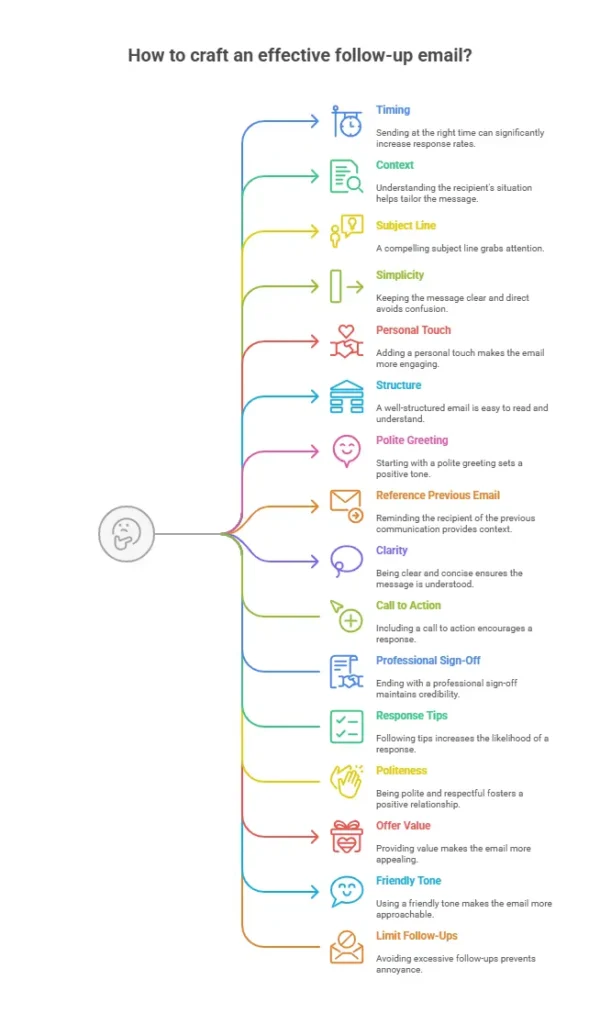Sending a follow-up email after receiving no response can feel like walking a tightrope. You want to be persistent enough to get noticed, but not so pushy that you annoy the recipient. Whether you’re reaching out to a potential client, a hiring manager, or a busy colleague, mastering the art of the follow-up email is essential to keeping communication alive and increasing your chances of success.
This guide will walk you through how to craft the perfect follow-up email that is polite, professional, and effective. From timing and tone to subject lines and content, every aspect matters when you want to turn silence into engagement.
Why Following Up Matters
It’s easy to assume that if someone doesn’t respond to your initial email, they’re not interested. However, the reality is often quite different. People get busy, emails get buried, and sometimes messages simply slip through the cracks. Following up shows that you are genuinely interested and proactive, qualities that are appreciated in any professional setting. A well-timed follow-up can serve as a gentle reminder of your initial outreach, and it can also provide an opportunity to add new information or insights that may spark the recipient’s interest. This can be particularly effective in industries where trends and information are constantly evolving.
Studies have shown that a large percentage of sales and job opportunities happen after multiple touches. In fact, 80% of sales require at least five follow-ups to close the deal. So, if you give up after one email, you might be missing out on valuable opportunities. Moreover, following up can help you to build rapport and establish a connection with your contacts. Each follow-up can be tailored to reflect your understanding of their needs and interests, making your communication more relevant and engaging. This personalized approach not only increases the likelihood of a response but also enhances your professional reputation as someone who is attentive and considerate.
Additionally, following up can provide you with valuable feedback. If your initial email didn’t resonate, a follow-up can prompt the recipient to share their thoughts, allowing you to refine your approach or offer something more aligned with their needs. This iterative process can be key in developing your skills in communication and negotiation. Remember, persistence in follow-ups can often convey your commitment and enthusiasm, which can be particularly appealing in competitive environments where many are vying for the same opportunities.

When to Send Your Follow-Up Email
Timing Is Key
Knowing when to send your follow-up email is just as important as what you write. Send it too soon, and you risk coming across as impatient or pushy. Wait too long, and the recipient might have forgotten about your initial message or moved on.
A good rule of thumb is to wait about three to five business days before sending your first follow-up. This gives the recipient enough time to catch up on their inbox without your message getting lost in a flood of new emails.
Consider the Context
The nature of your relationship and the urgency of your message should influence your timing. For example, if you’re following up on a job application, waiting a week or even two might be appropriate, as hiring managers often have many candidates to review. On the other hand, if you’re following up on a time-sensitive proposal, a quicker follow-up—perhaps after two or three days—makes more sense.
Crafting the Perfect Subject Line
The subject line is your first impression and can determine whether your email gets opened or ignored. It should be clear, concise, and relevant to the recipient.
Keep It Simple and Direct
Subject lines like “Following up on my previous email” or “Checking in regarding our proposal” are straightforward and professional. Avoid overly salesy or vague subject lines that might trigger spam filters or cause the recipient to overlook your message.
Add a Personal Touch
If possible, personalize the subject line to grab attention. For example, “Following up on our conversation about your marketing strategy” or “Quick question about the Smith project.” Personalization shows that the email is tailored to the recipient, increasing the likelihood of a response.
How to Structure Your Follow-Up Email
Start with a Polite Greeting
Begin your email with a courteous greeting that acknowledges the recipient by name. Using their first name can create a friendly tone, but if the relationship is more formal, stick to titles and last names.
Reference Your Previous Email
Briefly mention your initial email to provide context. This helps the recipient recall your earlier message and understand why you’re following up. For example, “I wanted to follow up on the email I sent last week regarding the partnership opportunity.”
Be Clear and Concise
Respect the recipient’s time by keeping your email short and to the point. Clearly state what you’re asking or hoping to achieve with the follow-up. Avoid long paragraphs or unnecessary details that might overwhelm the reader.
Include a Call to Action
End your email with a clear and polite call to action. Whether you want to schedule a meeting, get feedback, or confirm receipt, make it easy for the recipient to know what you want them to do next. For example, “Please let me know if you’re available for a quick call next week” or “I’d appreciate any updates you can share.”
Close with a Professional Sign-Off
Finish your email with a courteous closing such as “Best regards,” “Sincerely,” or “Thank you,” followed by your full name and contact information. This reinforces professionalism and makes it easy for the recipient to respond.
Tips for Writing a Follow-Up Email That Gets a Response
Be Polite and Respectful
Always maintain a respectful tone, even if you feel frustrated by the lack of response. Avoid sounding demanding or impatient. Phrases like “I understand you’re busy” or “I appreciate your time” can soften your message and make the recipient more inclined to reply.
Offer Value
Whenever possible, provide something of value in your follow-up email. This could be additional information, a helpful resource, or a new idea that relates to your previous conversation. Offering value shows that you’re not just chasing a response but genuinely interested in contributing.
Use a Friendly and Approachable Tone
People are more likely to respond to emails that feel human and personable. Avoid overly formal or robotic language. Instead, write as if you’re having a polite conversation, which can help build rapport and encourage engagement.
Limit the Number of Follow-Ups
While persistence is important, bombarding someone with multiple follow-up emails can backfire. Generally, one or two follow-ups after the initial email are sufficient. If you still don’t get a response, it might be time to move on or try a different communication channel.
Examples of Effective Follow-Up Emails
Example 1: Following Up After a Job Application
Subject:
Following up on my application for the Marketing Manager position
Dear Ms. Johnson,
I hope this message finds you well. I wanted to follow up on the application I submitted last week for the Marketing Manager role at BrightWave Solutions. I remain very enthusiastic about the opportunity to contribute to your team and would appreciate any updates you can share regarding the hiring process.
Thank you for your time and consideration. Please let me know if there’s any additional information I can provide.
Best regards,
Emily Carter
emily.carter@email.com
(555) 123-4567
Example 2: Following Up on a Sales Proposal
Subject: Checking in on the proposal for your upcoming product launch
Hi Mark,
I hope you’re doing well. I wanted to touch base regarding the proposal I sent last Thursday about supporting your upcoming product launch. I’m happy to answer any questions or provide further details if needed.
Would you be available for a brief call next week to discuss the next steps?
Looking forward to your thoughts.
Best,
Jason Lee
jason.lee@marketpros.com
(555) 987-6543
Example 3: Following Up After a Networking Event
Subject: Great meeting you at the Tech Innovators Conference
Hi Sarah,
It was a pleasure meeting you at the Tech Innovators Conference last week. I enjoyed our conversation about emerging trends in AI and wanted to follow up to see if you’d be interested in continuing our discussion over coffee sometime soon.
Let me know if that works for you!
Thanks again,
David Nguyen
david.nguyen@email.com
(555) 234-5678
Common Mistakes to Avoid in Follow-Up Emails
Being Too Pushy or Aggressive
Persistence is good, but aggression can damage your reputation. Avoid language that pressures the recipient or implies frustration. Keep your tone friendly and respectful at all times.
Sending Generic or Vague Messages
Personalization matters. Generic emails that don’t reference previous conversations or specific details are easy to ignore. Tailor each follow-up to the recipient and the context.
Ignoring Spelling and Grammar
Errors in your email can make you appear careless or unprofessional. Always proofread your message before hitting send to ensure it’s polished and error-free.
Failing to Provide a Clear Call to Action
Without a clear next step, the recipient might not know how to respond. Always include a specific, polite call to action to guide the conversation forward.
Final Thoughts
Writing the perfect follow-up email after no response is a skill that can open doors and build lasting professional relationships. By being timely, polite, clear, and value-driven, you increase your chances of turning silence into meaningful dialogue.
Remember, the goal of a follow-up email isn’t just to get a reply—it’s to foster communication and demonstrate your professionalism and genuine interest. With practice and attention to detail, your follow-up emails will become powerful tools in your communication arsenal.
Take Your Follow-Up to the Next Level with White Panther
While mastering the art of the follow-up email is crucial, imagine enhancing your productivity with WhitePanther’s AI-powered tool designed for freelancers, startups, and agile teams. Streamline your tasks, automate workflows, and collaborate with ease. Ready to transform how you work and follow up with unmatched efficiency?
Join our waitlist now and be the first to experience the future of work with White Panther.


